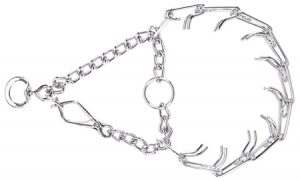Shock Collar Training or Pinch Collar Training?
We always get asked about electronic (shock) collars and pinch collars at our dog training facility in Northern Virginia. Many people refer to them as “shock” collars; however, they just give a low level stimulation (like stim pads).
There have actually been studies and research that have been conducted on electronic collars and pinch collars.
One of the notable studies was the Salgirli dissertation, which was aimed at investigating whether the rise in stress signals in dogs could be attributed to continued and persistent use of electric signals or pinching signals. The dissertation was further used to investigate whether or not a pinch color could be used as an alternative to electric collars and if so, whether or not the pinch collars would attest to the same stress results as previously recorded in the studies involving investigation of electric collars.
To achieve such results, a test group of forty-two adult police dogs, ranging in various breeds. The tests included the conditioning of the quitting signal, which was a conditioned frustration that is attributed to negative punishment. The test itself consisted of walking each test dog subject past a “provocateur” who each time attempted to taunt and tease the dog into precipitating a reaction. If the desired effect was not achieved by the dog, it was punished to determine a constant and a learning effect. The study then, unlike the Schalke Et Al, this dissertation was aimed to compare the differences between negative and positive methods. It was not a study aimed at understanding the use of punishment on positive reinforcement in dog training. To measure the results of this test, the scientists measured the learning effect of the dogs by assessing the number of dogs that learned over time to quit the behavior that precipitated the punishing stimuli.
The results of the test were interesting. There were no statistical variances in the learning effects that was measured between the pinch and the shock collars. But what was significant was the significantly lower learning effect in quitting signal that was measured from the two different collar types. In conclusion, the dissertation reviewed that the pinch collar caused more behavioral reactions in terms of stress; meaning the dogs exhibited more stress signals. These included pinned ears, panting and stress yawns. But the electronic shock collars caused more vocal reactions in the dogs meaning whines, barks and growls. The explanation as put forward by the study was that the increased level of vocalization in the shock collar results was to be attributed to a startled response rather than a response to a pain stimulus which was the results of the pinch collar.
Designed as a test to only measure the behavior changes in the test group of forty-two dogs, the dissertation does make note of their collection of the changes in salivary cortisol stress levels in the dogs but also notes that these changes were not of a large impact to the study. Coupled with the behavioral observations and the cortisol results, the Salgirli dissertation was able to determine that electronic collars inhibit less stress in dogs when compared to the results of the pinch collars which is shown to have produced more stress signal effects. The dissertation also notes that the test group only included adult test subjects and that the test subjects were subjected to a hard procedure designed to test the abilities of current and future police dogs.
Note, electronic collars should only be utilized by trained professionals.
Contact Off Leash K9 Training you are interested in making your dog amazing, more confident, and more obedient!
http://www.offleashk9training.com/ or 888-413-0896 or info@offleashk9training.com
Nick White
Owner/Founder
Off Leash K9 Training

